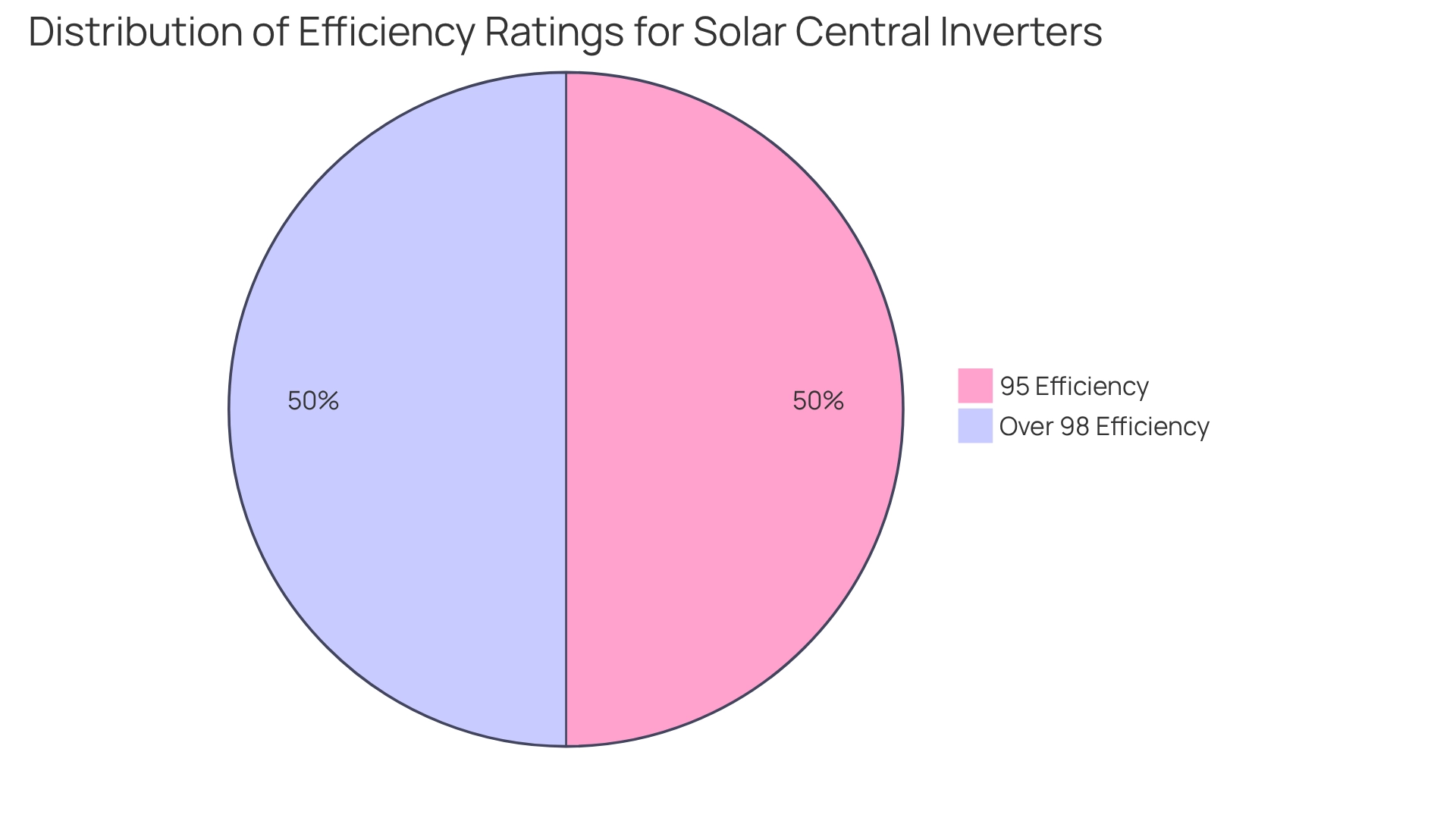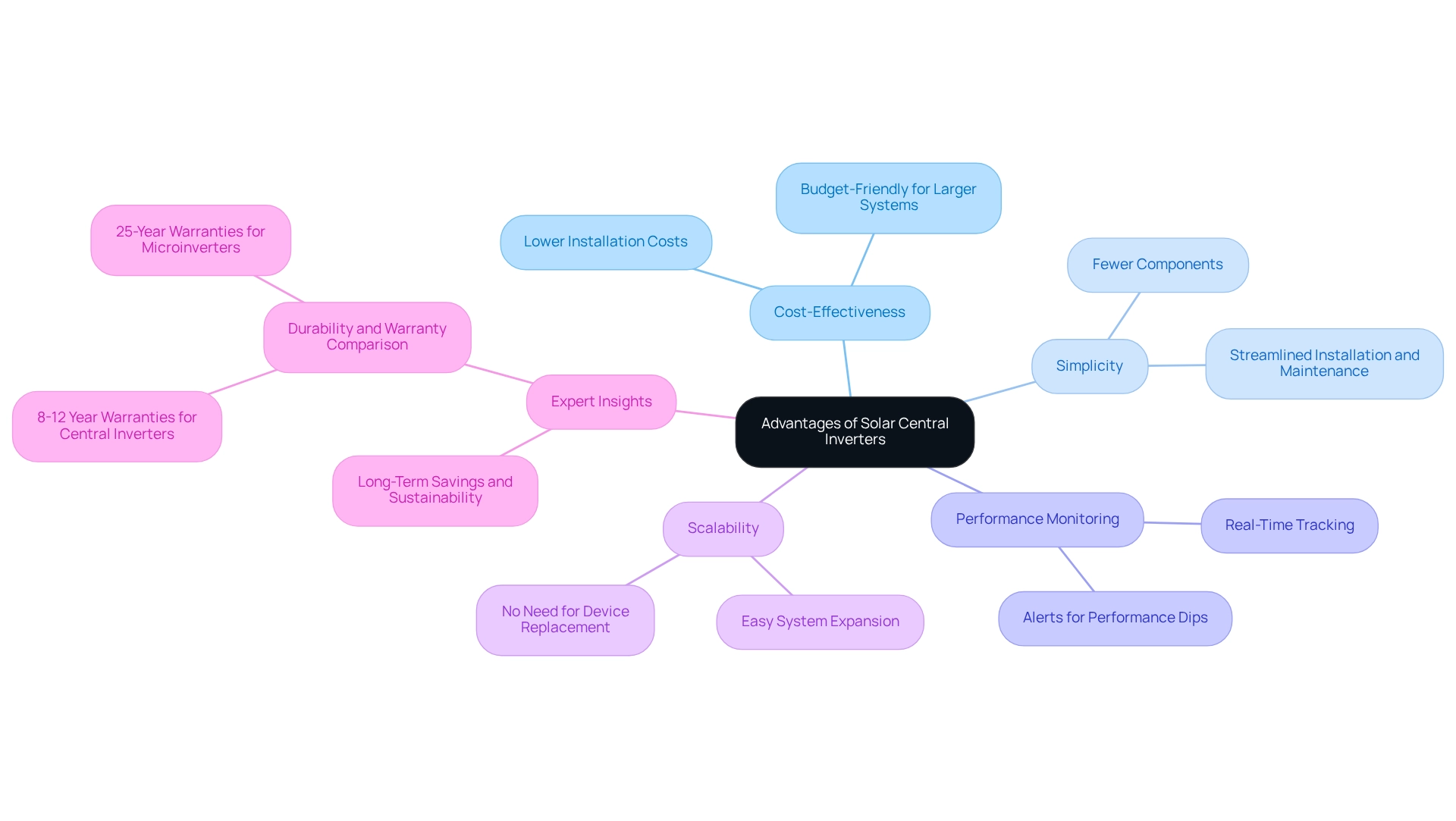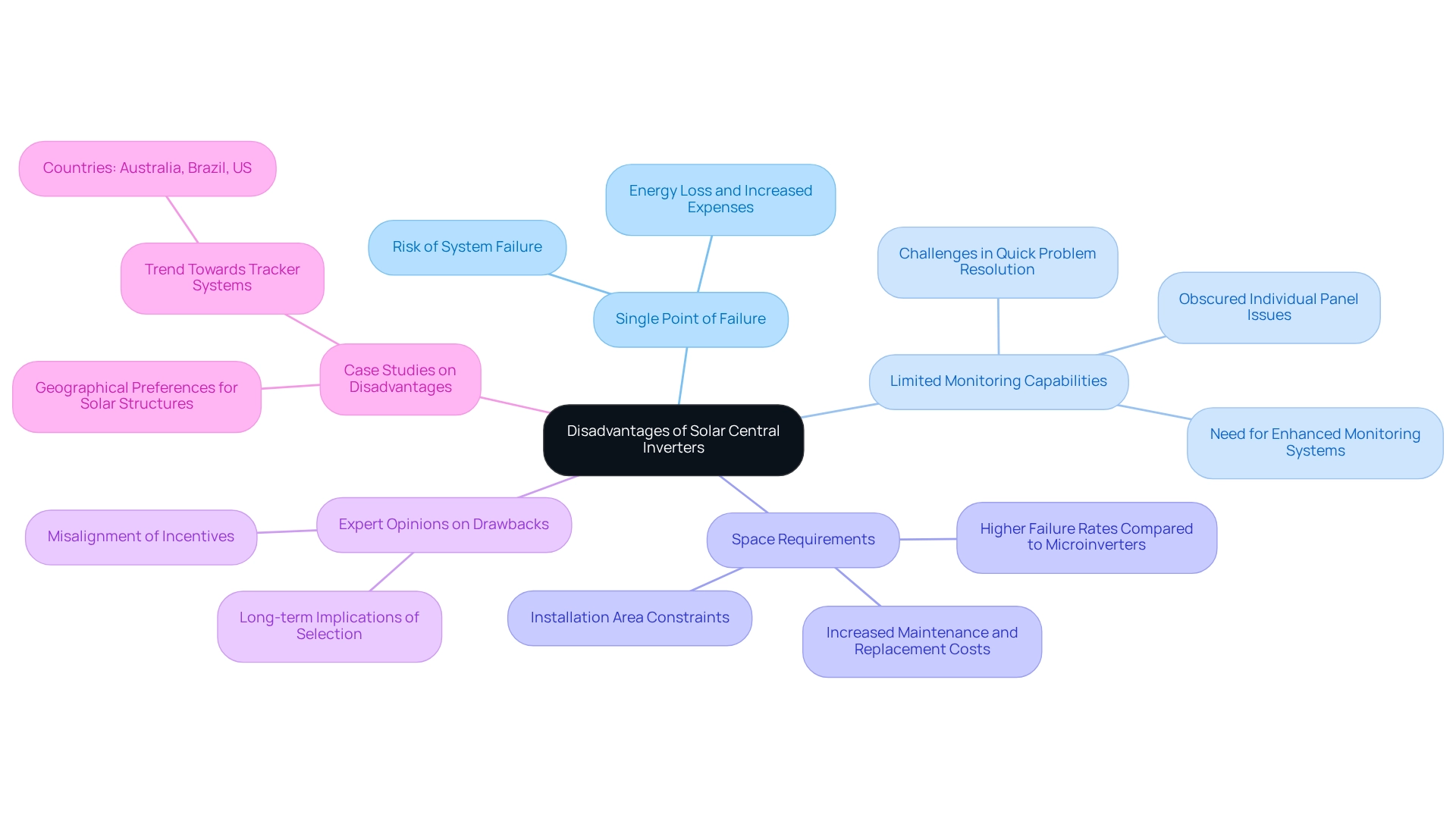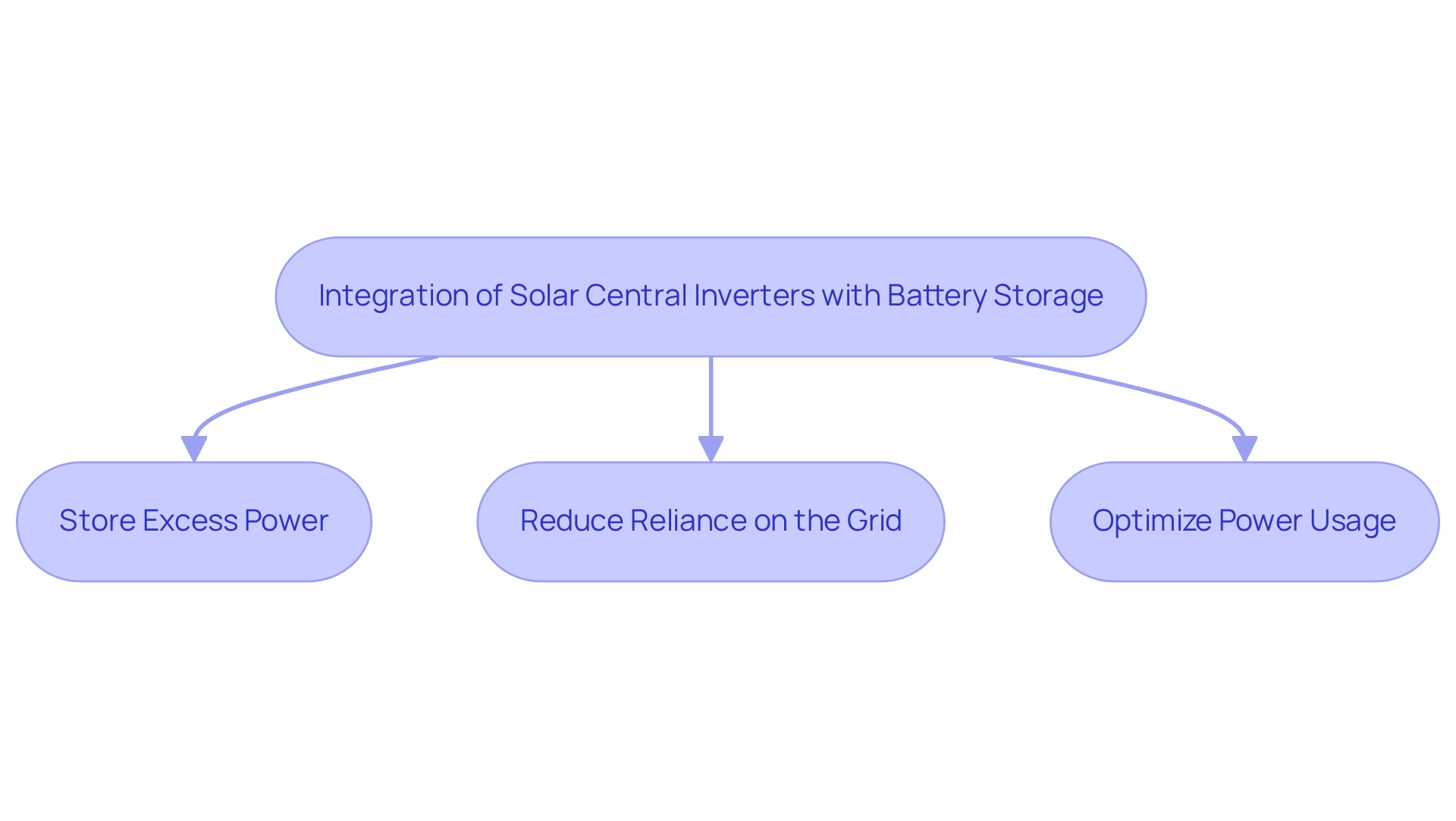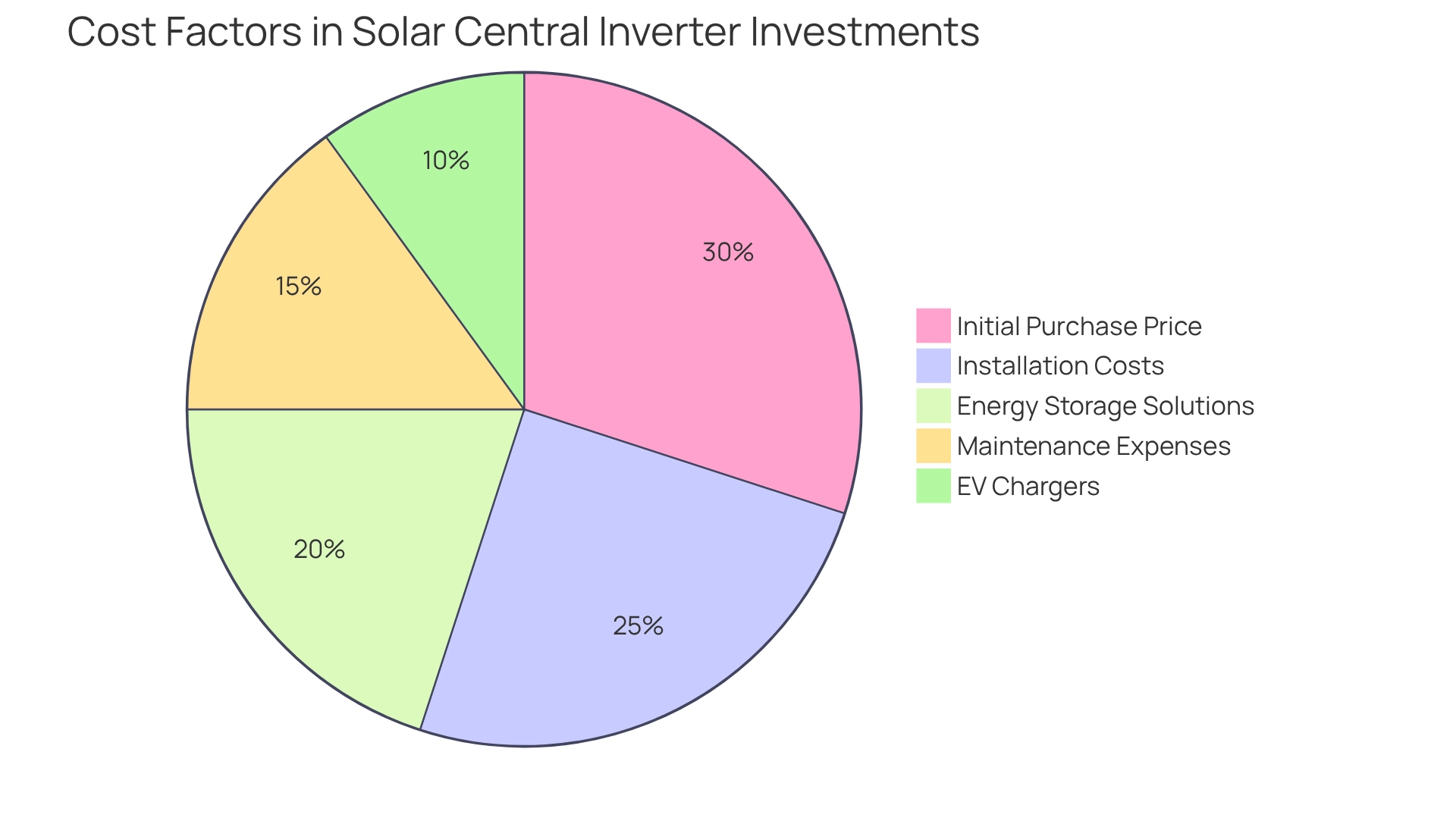Overview
As homeowners, we often find ourselves grappling with rising energy bills, and it’s completely understandable to seek solutions. The article highlights essential facts about solar central inverters, a technology that can transform your energy experience. These inverters play a crucial role by converting DC electricity from solar panels into AC electricity for home use, paving the way for cost-effectiveness and scalability in your energy consumption.
However, we recognize that making such a significant change can come with concerns. While solar central inverters offer numerous advantages, such as reducing reliance on traditional energy sources, it’s important to address potential drawbacks. For instance, the risk of a single point of failure and the necessity of regular maintenance are valid considerations that can impact your peace of mind.
Yet, imagine the sense of energy independence and the financial relief that comes with harnessing the power of the sun. Regular maintenance ensures optimal performance, allowing you to enjoy the benefits without worry. Together, we can navigate these challenges and embrace a sustainable future.
We invite you to reflect on your energy habits and consider how solar energy could fit into your life. If you’re ready to explore this journey towards energy independence, we’re here to support you every step of the way. Let’s work towards a brighter, more sustainable future together.
Introduction
In the heart of California’s solar energy revolution, we understand that many homeowners are concerned about rising energy bills and the need for sustainable solutions. Powercore Electric stands out as a trusted name, providing high-quality solar central inverters that empower you to harness clean energy effectively.
With over three decades of commitment to excellence and community engagement, this family-owned business not only delivers reliable energy solutions but also addresses your evolving needs in a rapidly changing energy landscape.
As the demand for solar energy surges, driven by rising utility costs and shifting policies, understanding the role and functionality of solar central inverters becomes crucial.
This article delves into the intricacies of solar central inverters, exploring their benefits, potential drawbacks, installation processes, and maintenance needs.
Together, we can highlight how Powercore Electric is uniquely positioned to guide you toward energy independence and sustainability, ensuring you feel supported every step of the way.
Powercore Electric: Leading Provider of Solar Central Inverters
At Powercore Electric, we understand that rising energy bills can be a source of anxiety for homeowners. For over 30 years, we have been a cornerstone of California’s renewable power scene, dedicated to not only providing solutions but also ensuring that each project reflects our commitment to community engagement and customer satisfaction. As a family-owned business, we take pride in offering that convert the direct current (DC) from photovoltaic panels into the alternating current (AC) needed for your home. This dedication to quality workmanship establishes us as a trusted supplier in the solar central inverter market, ensuring that you receive dependable and effective power solutions.
In addition to solar central inverters, we offer a variety of services, including EV charger installation and electrical panel upgrades, tailored to meet the diverse needs of homeowners like you. As the demand for renewable energy continues to grow, with California’s utilities facing a revenue requirement projected to rise by 5% to 10% in 2025, we are here to help you navigate these changes with confidence. Many homeowners are exploring battery storage options, with:
- 38% aiming to maximize savings on complicated utility rates
- 22% wanting to enhance their home usage of renewable energy
- 18% seeking emergency backup power
We recognize that the ongoing policy shifts impacting California’s rooftop energy market can present challenges, and we are well-equipped to guide you through them.
Customer satisfaction is at the heart of what we do. As Ryan, a recent client, shared, ‘Ryan and his team were great. They were fast, efficient, and stayed on schedule for our solar installation. I have referred Powercore to some friends, and they were also happy with their service.’ It’s common to feel uncertain about transitioning to renewable energy, but we want you to know that you are not alone. As Mark Jacobson, a professor of Civil and Environmental Engineering, highlights, fossil gas consumption is projected to decrease through 2025, underscoring the importance of embracing renewable power sources.
Together, we can improve your self-sufficiency and lower your expenses. Our emphasis on cutting-edge technology and community-oriented service makes Powercore Electric a reliable choice for residents seeking to make a positive change. Let’s work towards a more sustainable future, ensuring that your energy needs are met with care and expertise. We invite you to reach out to us today, and together we can explore the best solutions for your home.
Functionality of Solar Central Inverters: Converting DC to AC Power
We understand that rising energy bills can be a significant concern for homeowners. The solar central inverter for photovoltaic systems plays a crucial role in addressing this issue by transforming the direct current (DC) electricity generated by solar panels into alternating current (AC) electricity, which is essential for powering household appliances. This conversion is vital, as most home devices rely on AC power. Beyond enabling this transformation, these devices enhance power output by effectively managing the flow of electricity, ultimately maximizing savings and efficiency for you, the homeowner.
In 2025, we anticipate that of photovoltaic inverters will reach approximately 95%. This reflects ongoing advancements in technology and design that not only improve performance but also contribute to the overall reliability of energy systems. High-efficiency photovoltaic heating systems can save you between $400 to $600 annually on utility costs, according to estimates from the Energy Department. Additionally, high thermal efficiency ratings demonstrate how effectively these systems convert sunlight into usable heat, which is crucial for assessing their performance.
However, we recognize that addressing issues related to converter performance can sometimes be complex and costly, particularly if software updates or hardware replacements are necessary. A recent case study illustrated the effectiveness of a linear regression model in estimating power output based on environmental sensor data. This innovation aids in real-time monitoring and diagnostics of energy systems, ensuring optimal performance.
Expert opinions highlight the importance of the functionality of the solar central inverter. As Rachel Kurchin, an assistant research professor of materials science and engineering at Carnegie Mellon University, noted, “Devices may need to be replaced halfway through the lifetime of the panels.” This underscores the significance of considering device lifespan and maintenance when investing in photovoltaic technology. Moreover, advancements like the Solis Wi-Fi/Cellular data logging device ensure uninterrupted data transmission, even during local Wi-Fi outages, enhancing the functionality and reliability of photovoltaic systems.
Practical examples illustrate the effectiveness of DC to AC conversion in photovoltaic systems. Homeowners who have installed solar central inverters report substantial decreases in utility expenses and increased self-sufficiency. By harnessing the potential of sunlight energy through a solar central inverter, you can reduce your utility costs and contribute to a more sustainable energy future. Furthermore, asset performance management tools assist in decision-making for improving converter performance, emphasizing the importance of continuous management and optimization of energy systems. Additionally, using solar-powered heating systems can prevent roughly 2 tons of carbon dioxide from entering the atmosphere each year, further highlighting their ecological benefits.
Together, we can explore these sustainable solutions to enhance your energy independence and foster a healthier planet for future generations.
Efficiency Ratings of Solar Central Inverters: Maximizing Energy Output
We understand that managing energy bills can be a significant concern for homeowners. Efficiency ratings for typically range from 95% to more than 98%. This means that for every 100 watts of DC power generated, you can expect 95 to 98 watts to be transformed into usable AC power. By selecting a high-efficiency solar central inverter, you can greatly enhance the functionality of your photovoltaic system and maximize your investment in renewable technology.
It’s common to feel uncertain about the effectiveness of renewable energy solutions, especially in regions like Stockton, California, where overcast days can impact solar energy generation. Therefore, it’s essential to explore options that perform reliably even under less-than-ideal conditions. Consistent advancements in solar central inverter technology continue to improve these efficiency ratings, making it crucial for property owners to stay informed about the latest alternatives.
Together, we can assess local companies that offer customized solutions tailored to your power requirements. Let’s work towards achieving energy independence and a sustainable future, ensuring that you feel supported every step of the way.
Advantages of Solar Central Inverters: Benefits for Homeowners
Are you feeling overwhelmed by rising energy bills? Solar central inverters provide numerous advantages for homeowners, establishing them as a compelling choice for solar energy systems, particularly when taking into account the expertise and commitment of Powercore Electric.
- Cost-Effectiveness: Solar central inverters typically have lower installation costs compared to using , making them a budget-friendly option for larger solar systems. This cost efficiency is especially advantageous for property owners seeking to optimize their investment in renewable resources, aligning with Powercore Electric’s commitment to providing customized solutions that suit your particular location.
- Simplicity: With fewer components involved, solar central inverter systems streamline both the installation and maintenance processes. This simplicity not only reduces labor costs but also minimizes potential points of failure, enhancing overall system reliability—an aspect that reflects Powercore Electric’s commitment to unmatched quality craftsmanship.
- Performance Monitoring: Many central inverters come equipped with sophisticated monitoring systems, allowing you to track power generation and system functionality in real-time. This feature empowers you to enhance your energy consumption and identify any issues promptly. For instance, you can receive alerts about performance dips, ensuring timely maintenance that can lead to increased energy savings, reinforcing Powercore Electric’s customer-first approach.
- Scalability: Solar central inverter units are designed to accommodate system expansions effortlessly. If you plan to enhance your solar capacity in the future, you can do so without needing to substitute current devices. This contrasts with microinverters, which, while facilitating incremental panel additions, may require more extensive system overhauls. Powercore Electric’s local expertise ensures that these expansions are handled with care and precision, providing you with confidence in your investment.
- Expert Insights: Industry experts highlight that solar central inverters not only provide a cost-effective solution but also offer long-term savings and sustainability benefits. Their durability is underscored by warranties that typically range from 8 to 12 years, compared to the 25-year warranties often associated with microinverters. As Daniyal Ahmed states, “No matter which path you choose, adopting renewable power is a step toward sustainability and long-term savings—a benefit for your wallet and the planet.”
- Performance Monitoring Examples: You can leverage performance monitoring features to ensure your system is operating at peak efficiency. For instance, examining power generation data can help you identify the optimal moments to operate energy-consuming appliances, thus enhancing your savings.
In summary, solar central inverters provide a combination of cost-effectiveness, simplicity, and scalability, making them a beneficial option for individuals seeking to invest in renewable power solutions. With Powercore Electric’s local knowledge and dedication to sustainable initiatives, you can feel assured in your choice to utilize renewable power. Together, let’s explore how we can assist you in harnessing the advantages of sunlight.
Disadvantages of Solar Central Inverters: Potential Drawbacks to Consider
As you consider the benefits of photovoltaic systems, it’s important to also reflect on some notable drawbacks associated with solar central inverters that may impact your decision:
- Single Point of Failure: One significant concern is the risk of a single point of failure. If the solar central inverter malfunctions, the entire solar system could stop functioning until repairs are made. This situation can lead to energy loss and increased expenses, which is understandably worrying for homeowners.
- Limited Monitoring Capabilities: Central devices often provide system-wide performance data, but this can obscure issues at the individual panel level. This limitation makes it more challenging for you to quickly identify and resolve problems, unlike microinverters that allow for detailed monitoring of each panel. By enhancing monitoring systems integrated into solar central inverters, you can reduce costs related to failure detection, highlighting a critical drawback of centralized systems.
- Space Requirements: The installation of solar central inverters necessitates a specific area, which may not be feasible for all homeowners, especially those with limited installation space. This requirement can complicate the integration of photovoltaic systems into your existing home layout, especially considering that solar central inverters may experience higher failure rates compared to microconverter counterparts. This increased risk can result in more frequent maintenance and replacement costs, affecting the overall efficiency of your solar energy system. In contrast, microinverters and power optimizers often come with a 25-year warranty, emphasizing their reliability as alternatives.
- Expert Opinions on Drawbacks: Experts highlight that misalignment of incentives between owners and operators can lead to varying opportunity costs, complicating the decision-making process regarding your selection. Understanding the long-term implications of choosing a solar central inverter is essential, as supported by research backed by FCT through IDMEC under LAETA, project UID/EMS/50022/2020.
- Case Studies on Disadvantages: Studies reveal geographical preferences for photovoltaic structures, showing a trend towards tracker systems over fixed structures in large countries like Australia, Brazil, and the US. This trend suggests an increasing inclination towards solutions that enhance efficiency and adaptability, which may not align with the constraints of central systems.
In summary, while central systems may be a viable option for certain installations, we encourage you to thoughtfully weigh these drawbacks against your specific energy needs and installation circumstances. Together, we can navigate these considerations to find for your home.
Installation Process of Solar Central Inverters: What to Expect
We understand that managing energy bills can be a significant concern for homeowners. The installation procedure of solar central inverters involves several crucial stages to guarantee a seamless and efficient setup that addresses these worries:
- Site Assessment: A certified expert assesses your property to determine the best positions for the energy converter and photovoltaic panels, taking into account sunlight exposure and shading.
- Permitting: Securing necessary permits from local authorities is essential to ensure compliance with regulations before installation begins.
- Mounting: The device is securely installed, typically in a shaded area to minimize overheating risks that can affect performance and longevity.
- Wiring: Skilled electricians connect the power converter to the photovoltaic panels and integrate it with your home’s electrical system for seamless energy flow.
- Assessment: Following installation, the system undergoes a thorough assessment to verify connections and observe performance, ensuring that all components operate properly before activation.
Adequate planning and implementation during these stages are vital for a successful setup, enhancing the durability and efficiency of your energy system. Routine upkeep, which includes cleaning and performance evaluation, is crucial to prolong the device’s lifespan and guarantee stable functioning. Powercore Electric is here to provide extensive services for the setup and upkeep of and battery storage systems, boosting energy autonomy and cost reductions for residents. As a practical suggestion, let’s work together to arrange routine maintenance inspections to ensure optimal performance and longevity of your energy systems. Together, we can create a sustainable energy future that brings peace of mind.
Maintenance Needs of Solar Central Inverters: Ensuring Longevity
Maintaining the solar central inverter devices is crucial for maximizing their lifespan and ensuring optimal performance. We understand that many homeowners are concerned about rising energy bills, and that’s where effective maintenance comes in. Here are key practices to consider:
- Regular Inspections: Homeowners should conduct visual inspections of their inverters to identify any signs of damage or wear. This proactive approach can help catch issues early, preventing costly repairs down the line.
- Cleaning: Keeping the device clean and free from dust and debris is essential. Accumulated dirt can lead to overheating, negatively impacting performance. Routine cleaning aids in sustaining efficiency and extends the lifespan of the device. As mentioned, ensuring that photovoltaic panels are clean is essential for enhancing energy output, as dirt and debris can obstruct sunlight and impede performance.
- Professional Servicing: Engaging a qualified technician for routine maintenance checks is vital. These professionals can perform thorough inspections and identify potential issues before they escalate. Powercore Electric’s in-house team exemplifies this commitment to quality service, ensuring that installations and maintenance are handled with expertise.
- Maintenance Checklist: A comprehensive maintenance checklist for photovoltaic systems includes monitoring the battery environment, checking connections, inspecting the control panel, and ensuring proper ventilation. Adhering to this checklist can assist in preserving the device’s functionality and efficiency over time.
- Cost Considerations: While maintenance expenses for photovoltaic devices can differ, investing in regular upkeep can result in substantial savings over time. The typical lifespan of solar central inverters is approximately 5 to 10 years, and appropriate upkeep can prolong this period, optimizing the return on investment. Homeowners can anticipate reductions in utility expenses, with typical savings from renewable sources computed immediately without the need for personal details.
- Expert Insights: According to renewable power specialist John Smith, “Regular maintenance helps ensure that panels are functioning at peak performance and generating the maximum amount of electricity.” By cleaning panels and preserving their state, you can enhance power generation and attain the highest return on your investment in renewable technology. This emphasizes the significance of preserving the state of the device to enhance power generation.
By following these maintenance practices, together we can ensure the longevity and efficiency of , ultimately enhancing your independence and sustainability. Let’s work towards a brighter, more sustainable future together.
Integration of Solar Central Inverters with Battery Storage: Enhancing Energy Independence
We understand that managing energy bills can be a source of stress for many homeowners. Incorporating solar central inverters along with battery storage solutions can greatly enhance self-sufficiency, providing you with the peace of mind you deserve. This powerful combination, including the solar central inverter, allows property owners to:
- Store Excess Power: Surplus power generated during the day can be stored in batteries, ensuring you have energy available during the night or during power outages, thus guaranteeing a continuous supply.
- Reduce Reliance on the Grid: By utilizing a battery storage system in conjunction with a solar central inverter, you can decrease your dependence on the grid, leading to and enhanced power security.
- Optimize Power Usage: Strategically deploying stored power during peak demand periods, when electricity rates are higher, enables you to maximize savings and fully capitalize on your renewable investment.
The integration of the solar central inverter with battery systems not only promotes your independence but also aligns with the growing trend of sustainable practices. At Powercore Electric, we are dedicated to providing you with customized solutions that cater to your specific power requirements. Together, we can work towards achieving your energy independence with renewable solutions. To learn more about how we can support you, reach out for a complimentary consultation today!
Cost Considerations for Solar Central Inverters: Budgeting for Your Investment
When budgeting for solar central inverters, we recognize that homeowners frequently have concerns regarding and the long-term financial implications. It’s essential to consider several key cost factors:
- Initial Purchase Price: The cost of a central inverter typically ranges from $1,500 to $3,000, influenced by the brand and specifications. This investment is crucial as it directly impacts the efficiency of the solar central inverter in your solar energy system. The installation costs for a solar central inverter can add an additional $1,000 to $2,000 to the overall expense, depending on the complexity of the installation. Hiring skilled installers guarantees maximum efficiency and durability of the device.
- Maintenance Expenses: Although maintenance costs are generally low, it’s wise to budget for periodic professional inspections and potential repairs throughout the inverter’s lifespan. Regular maintenance can prevent costly issues and extend the life of your system.
Understanding these expense elements is crucial for property owners aiming to make informed financial choices about their energy investments. By grasping installation quotes, customers can work towards reducing costs and enhancing efficiency, making this a vital component of the budgeting process. For instance, a case study on budgeting for solar central inverters emphasizes the significance of calculating the cost per watt, allowing property owners to compare the cost-effectiveness of different installations efficiently. This comparison can lead to better financial decisions and ultimately enhance your savings.
Furthermore, with 28% of all new photovoltaic setups now incorporating storage solutions, it’s important to evaluate how this trend affects your overall expenses and potential savings. Integrating energy storage systems can further enhance energy efficiency and provide backup power during outages. Moreover, as you assess your options, understanding the expenses linked to EV chargers is essential, particularly as many individuals are contemplating renewable solutions for electric vehicle charging. EV chargers can range from $400 to $1,200, depending on the type and installation requirements.
By utilizing platforms like EnergySage, property owners can streamline the process of acquiring and comparing energy quotes, ensuring clarity and improved budgeting results. As Ben Zientara, a Renewable Energy Policy Analyst, notes, “Getting renewable energy installed represents a multi-decade commitment,” underscoring the importance of thorough budgeting and planning for long-term benefits. Additionally, comparing energy service providers can assist you in discovering the best value for your investment, ensuring you make informed decisions that align with your financial objectives. Together, we can navigate these choices and work towards a more sustainable future.
Future Trends in Solar Central Inverter Technology: What to Expect
The future of photovoltaic central converter technology is poised for significant advancements, driven by a number of key trends that can truly make a difference for homeowners like you:
- Increased Efficiency: With ongoing innovations in converter technology, we anticipate higher efficiency ratings that will maximize energy output for your home. This is particularly important as the U.S. has recently surpassed 50 GW of online module manufacturing capacity, signaling a robust growth trajectory in renewable energy technology. This growth not only enhances accessibility to these technologies but also holds the potential for cost reductions, making solar energy more attainable for everyone.
- Intelligent Devices: Imagine power conversion devices that incorporate advanced technology, transforming how you manage your energy systems. With these improvements, you can enjoy enhanced features that help optimize power usage, leading to more effective consumption and savings on your energy bills.
- Hybrid Systems: The emergence of hybrid devices that combine sunlight generation with battery storage will empower you to achieve greater energy independence. These systems allow for flexible power management, enabling you to store excess energy for future use, which enhances reliability during outages.
- Market Dynamics: As the demand for larger SB-certified devices (over 250 kW) continues to rise, there may be concerns regarding their availability. This potential scarcity could lead to increased competition in procurement, affecting projects that require these larger models. For homeowners, this could mean possible delays or higher costs in obtaining essential equipment for your energy installations.
- Expert Insights: Industry experts predict that the utility-scale segment will keep expanding, with significant advancements expected in power conversion technology. Michael Schmela, Executive Advisor and Director of Market Intelligence at SolarPower Europe, highlighted that this segment grew from 2.2 GW in 2021 to 3 GW in 2022. This growth is crucial for meeting the rising energy demands and sustainability goals that matter to you.
- Delivery Timeline: Looking ahead, it is estimated that deliveries from most manufacturers could take place between March and August of 2023. This timeframe will be critical for the availability of new technologies that can enhance your residential solar systems, with trends painting a promising picture for , positioning them as essential components in our collective journey towards sustainable energy solutions. Together, we can embrace these advancements and work towards a brighter, more energy-efficient future.
Conclusion
We understand that the rising energy bills can be a source of concern for many homeowners. The exploration of solar central inverters reveals their pivotal role in the transition to renewable energy, offering a pathway to reduce these costs while enhancing sustainability. Powercore Electric stands out as a trusted provider, bringing over three decades of experience and a commitment to community engagement. Their high-quality solar central inverters not only convert DC power into usable AC power but also optimize energy savings, showcasing their importance in maximizing the efficiency of solar energy systems.
While central inverters present significant advantages, such as cost-effectiveness and simplicity, it’s common to feel apprehensive about potential drawbacks. Issues like single points of failure and limited monitoring capabilities highlight the importance of thorough research and understanding of your personal energy needs. However, with proper maintenance and integration with battery storage systems, homeowners can significantly enhance their energy independence and overall savings.
As the solar energy landscape evolves, so too do the technologies that support it. Innovations in inverter efficiency and the rise of smart inverters promise to further empower homeowners in managing their energy use effectively. By partnering with experts like Powercore Electric, you can navigate these advancements and make informed decisions that align with your sustainability goals.
In conclusion, embracing solar energy through the use of central inverters not only offers financial benefits but also contributes to a more sustainable future. Together, we can harness the full potential of solar energy, reducing reliance on traditional energy sources and fostering a cleaner environment for generations to come. With the right support and technology, let’s work towards a brighter, more sustainable future.



